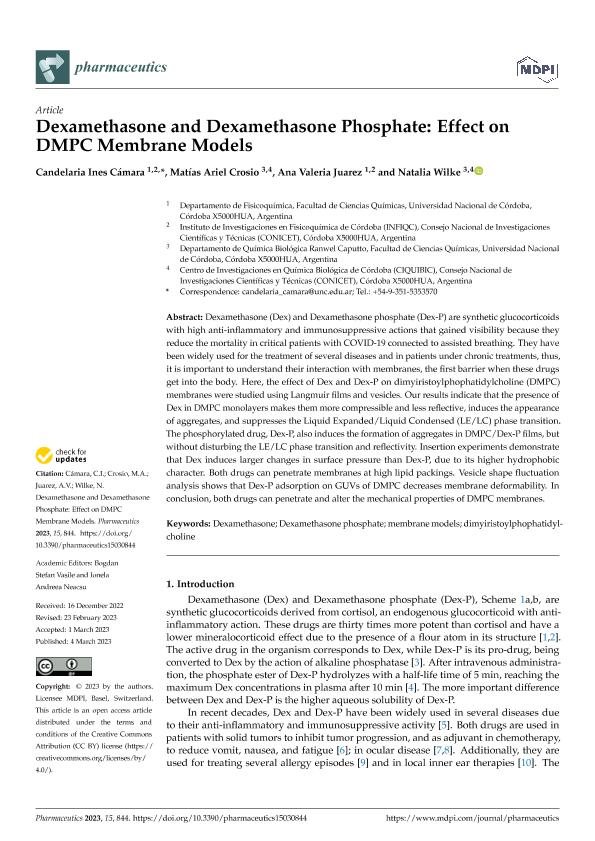Artículo
Dexamethasone and Dexamethasone Phosphate: Effect on DMPC Membrane Models
Fecha de publicación:
03/2023
Editorial:
MDPI
Revista:
Pharmaceutics
ISSN:
1999-4923
Idioma:
Inglés
Tipo de recurso:
Artículo publicado
Clasificación temática:
Resumen
Dexamethasone (Dex) and Dexamethasone phosphate (Dex-P) are synthetic glucocorticoids with high anti-inflammatory and immunosuppressive actions that gained visibility because they reduce the mortality in critical patients with COVID-19 connected to assisted breathing. They have been widely used for the treatment of several diseases and in patients under chronic treatments, thus, it is important to understand their interaction with membranes, the first barrier when these drugs get into the body. Here, the effect of Dex and Dex-P on dimyiristoylphophatidylcholine (DMPC) membranes were studied using Langmuir films and vesicles. Our results indicate that the presence of Dex in DMPC monolayers makes them more compressible and less reflective, induces the appearance of aggregates, and suppresses the Liquid Expanded/Liquid Condensed (LE/LC) phase transition. The phosphorylated drug, Dex-P, also induces the formation of aggregates in DMPC/Dex-P films, but without disturbing the LE/LC phase transition and reflectivity. Insertion experiments demonstrate that Dex induces larger changes in surface pressure than Dex-P, due to its higher hydrophobic character. Both drugs can penetrate membranes at high lipid packings. Vesicle shape fluctuation analysis shows that Dex-P adsorption on GUVs of DMPC decreases membrane deformability. In conclusion, both drugs can penetrate and alter the mechanical properties of DMPC membranes.
Archivos asociados
Licencia
Identificadores
Colecciones
Articulos(CIQUIBIC)
Articulos de CENTRO DE INVEST.EN QCA.BIOL.DE CORDOBA (P)
Articulos de CENTRO DE INVEST.EN QCA.BIOL.DE CORDOBA (P)
Articulos(INFIQC)
Articulos de INST.DE INVESTIGACIONES EN FISICO- QUIMICA DE CORDOBA
Articulos de INST.DE INVESTIGACIONES EN FISICO- QUIMICA DE CORDOBA
Citación
Cámara, Candelaria Inés; Crosio, Matias Ariel; Juárez, Ana Valeria; Wilke, Natalia; Dexamethasone and Dexamethasone Phosphate: Effect on DMPC Membrane Models; MDPI; Pharmaceutics; 15; 3; 3-2023; 1-20
Compartir
Altmétricas




